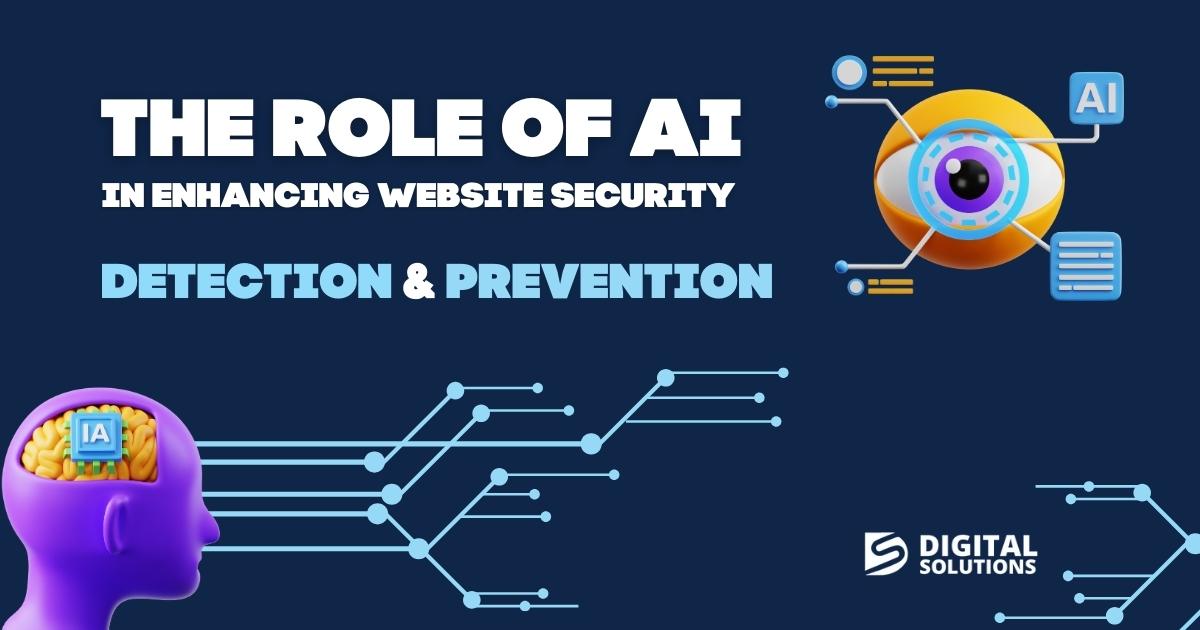
In today's hyper-connected world, websites face a constant barrage of cyber threats. From malicious attacks to data breaches, the risks to website integrity and user trust are ever-increasing. Fortunately, artificial intelligence (AI) is emerging as a powerful weapon in the fight against cybercrime, offering innovative solutions to enhance website security and protect valuable data.
1. Predictive Threat Detection: Anticipating Attacks Before They Happen
One of the most significant advantages of AI in website security lies in its ability to proactively detect and prevent threats. AI-powered algorithms constantly analyze website traffic patterns, identifying anomalies and suspicious activities that may indicate an impending attack.
Machine learning models are trained to recognize patterns associated with various types of cyberattacks, such as:
* Suspicious login attempts: Unusual login attempts from unfamiliar locations or devices.
* Malware injections: Attempts to inject malicious code into website files or databases.
* SQL injection attacks: Exploits vulnerabilities in databases to steal sensitive information.
* Cross-site scripting (XSS) attacks: Injects malicious scripts into web pages to steal user data or hijack sessions.
By detecting these anomalies in real-time, AI-powered systems can alert website administrators to potential threats, allowing them to take immediate action to mitigate the risk.
2. Intelligent Firewall Optimization: A Dynamic Shield
Traditional firewalls rely on static rules to filter traffic. However, AI-driven firewalls take a more dynamic and intelligent approach.
AI optimizes firewall rules by continuously analyzing traffic patterns and adapting to evolving threats. This includes:
* Dynamic traffic filtering: Adapting filtering rules based on real-time threat intelligence and user behavior.
* Granular access control: Fine-grained control over user access and permissions based on their role and activity.
* Intelligent rate limiting: Automatically adjusting traffic rates to mitigate denial-of-service (DoS) attacks.
* Adaptive IP blocking: Blocking malicious IP addresses based on real-time threat intelligence and behavioral analysis.
This dynamic approach enhances the effectiveness of firewalls, providing more robust protection against sophisticated attacks while minimizing the risk of legitimate traffic being blocked.
3. Automated Vulnerability Patching: Staying Ahead of the Curve
Software vulnerabilities are a constant target for cybercriminals. AI-powered tools can significantly improve the vulnerability management process by:
Real-time vulnerability scanning: Continuously scanning websites for known vulnerabilities and zero-day exploits.
Automated patch deployment: Automatically deploying security patches and updates to address identified vulnerabilities.
Dependency management: Monitoring and updating dependencies to ensure they are free from known vulnerabilities.
Continuous monitoring: Continuously monitoring for new vulnerabilities and proactively addressing potential threats.
By automating these critical tasks, AI empowers organizations to stay ahead of the curve and minimize the risk of exploitation.
4. Enhanced Authentication and Authorization: Securing User Access
Strong authentication is crucial for website security. AI-driven authentication methods enhance security by:
AI-powered password strength analysis: Assessing password complexity and providing feedback to users to encourage the creation of strong, unique passwords.
Behavioral biometrics: Analyzing user behavior patterns, such as typing speed and mouse movements, to detect and prevent unauthorized access.
Two-factor authentication (2FA): Implementing multi-factor authentication methods, such as two-factor authentication, to add an extra layer of security.
Role-based access control (RBAC): Granting users access to specific resources and functionalities based on their roles and responsibilities within the organization.
These advanced authentication methods enhance security while providing a seamless user experience.
5. Continuous Monitoring and Incident Response: Rapid Detection and Containment
AI-powered security solutions enable continuous monitoring of website activity and provide rapid incident response capabilities.
Real-time threat intelligence: Leveraging real-time threat intelligence feeds to stay informed about the latest threats and vulnerabilities.
Anomaly detection: Detecting unusual activity patterns that may indicate a security breach, such as unusual login attempts, data exfiltration, or malicious code execution.
Automated incident response: Triggering automated responses to security incidents, such as blocking malicious traffic, isolating infected systems, and notifying security personnel.
Forensic analysis: Analyzing security logs and other data sources to identify the root cause of security incidents and gather evidence for investigations.
By automating these critical functions, AI empowers organizations to respond quickly and effectively to security incidents, minimizing the impact and reducing the risk of data breaches.
Additional Benefits of AI-Powered Website Security
Reduced false positives: AI-driven systems can minimize false alarms, reducing the burden on security teams and improving operational efficiency.
Improved incident response time: Faster detection and response to security incidents can significantly reduce the impact of attacks and minimize downtime.
Enhanced compliance: AI-powered security solutions can help organizations comply with relevant security regulations and industry standards.
Increased scalability: AI-powered solutions can easily scale to accommodate the growing needs of businesses as they expand.
Cost savings: By automating many security tasks and reducing the need for manual intervention, AI-powered solutions can help organizations reduce the costs associated with website security.
Implementing AI-Powered Security
Integrate AI-driven security tools: Implement a range of AI-powered security tools, such as firewalls, intrusion detection systems, and security information and event management (SIEM) systems.
Train AI models on historical data: Train AI models on historical data related to website traffic, security incidents, and other relevant information to improve their accuracy and effectiveness.
Continuously monitor and update: Continuously monitor the performance of AI-powered security tools and update them regularly to address new threats and vulnerabilities.
Combine AI with human expertise: While AI can automate many security tasks, human expertise is still crucial for decision-making, incident response, and strategic planning.
Stay updated on AI advancements: Keep abreast of the latest advancements in AI-powered security technologies and explore new ways to leverage AI to enhance your website's security posture.
Conclusion
AI is revolutionizing website security, providing proactive protection against a constantly evolving threat landscape. By leveraging the power of AI, organizations can enhance their security posture, reduce the risk of data breaches, and protect their online presence from malicious attacks.
By implementing AI-powered security solutions, such as those offered by SIFO, and staying abreast of the latest advancements in this field, organizations can build a robust and resilient security framework that safeguards their website and protects their valuable data.